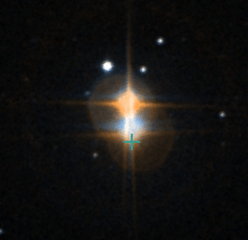Star of the Month
R Hydrae
Position: 13 hrs 29 min 42.8 sec -23 degrees 16 min 53 sec
Due south at 22:57 (BST) on 15 May 2022
R Hydrae
Image: Simbad (http://simbad.u-strasbg.fr/simbad/)
This is another dying red giant star: a Mira variable which is approaching the thermal-pulsing tip of the asymptotic giant branch. Like Mira it displays dramatic changes in brightness from 4.5 – which is naked eye brightness – to 10, which would be barely visible even in a 5” telescope. So basically it is yet another variable which you either see or you don’t. Its period when first studied in the eighteenth century was about 500 days, but this then declined to 385 days; which may be slowly declining. The change may have been brought about by a helium flash (see Star of the Month for June 2021). R Hydrae has a mass twice that of the Sun, but its diameter may be as large as 631 solar diameters; a size which in our solar system would mean it extends as far out as the asteroid belt. Its B-V value of 1.3 suggests that it will be yellow in the telescope, like many red giants. It is a member of the Hyades supergroup, a flow of stars which have the same trajectory as the Hyades cluster. It is 410 light years away from us. R Hydrae was the third Mira variable to be discovered, after Mira itself and Chi Cygni which I covered in March 2022.
R Hydrae was noted by Johannes Hevelius in 1662, but when Geminiano Montanari at the Paris Observatory looked for it seven years later, he could not find it, and assumed an error had been made. Its variability was discovered by Giacomo Maraldi, the nephew of Giovanni Cassini, in 1704. He was aware of Montanari’s non-observation and hunted the missing star down, seeing it in 1704 and 1708. To find R Hydrae, go down from Spica in Virgo towards to the horizon. About halfway to the horizon you will see two stars in an east-west line, they are Gamma Hydrae and Psi Hydrae. Their magnitudes are 3.0 and 4.9, but they will be heavily extincted as they are near the horizon. Make a line between Psi Hydrae and Gamma Hydrae and continue as far again and thus be almost directly under Spica. This is where R Hydrae will be if you can see it. Be aware it is very low in the sky; barely 15 degrees above the horizon when due south and best seen near the meridian; even if it is near maximum it will be extincted (dimmed) by nearly a magnitude.
